Investigation of the Magnetosphere of Ganymede with Galileo's Energetic Particle Detector
Ph.D. dissertation by Shawn M. Stone, University of Kansas,
1999.
Copyright 1999 by Shawn M. Stone. Used with permission.
6.3.1 Feature G2-18:56:31 (continued)
The lower energy electron results are more interesting. For model M1 in extended bounce mode a signature at a pitch near 180° is predicted to happen, as can be seen in Figures 6.66 and 6.67. If the scattering coefficient is increased the feature does fill in. The extended bounce mode results for model M2 do not exhibit an electron anti-loss cone for this feature, as observed in the real data (Figure 6.68). A detailed trace should reveal why this is taking place.
 |
Figure 6.66 (A) Simulated M1 and real (Re) rate profile for feature G2-18:56:31 of Channel F2 normalized to 90º pitch. The simulated runs are done in extended bounce mode with scattering included. Scattering coefficients are 5 and 1. (B) The pitch and phase angles are computed from the look direction of the EPD detector and the appropriate magnetic field vector R for real and S for simulated. |
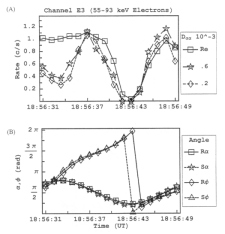 |
Figure 6.67 (A) Simulated M1 and real (Re) rate profile for feature G2-18:56:31 of Channel F2 normalized to 90º pitch. The simulated runs are done in extended bounce mode with scattering included. Scattering coefficients are .6 and .2. (B) The pitch and phase angles are computed from the look direction of the EPD detector and the appropriate magnetic field vector R for real and S for simulated. |
 |
Figure 6.68 (A) Simulated M2 and real (Re) rate profile for feature G2-18:56:31 of Channel F2 normalized to 90º pitch. The simulated runs are done in extended bounce mode with scattering included. (B) The pitch and phase angles are computed from the look direction of the EPD detector and the appropriate magnetic field vector R for real and S for simulated. |
The candidate look directions for tracing are extracted from the simulated rates shown in Figure 6.66 for model M1 and Figure 6.68 for model M2. The collimator pitch and phase scatter plot for this point extracted from model M1 is shown in Figure 6.69. Subenergy 74 keV was chosen. The look direction chosen for tracing is sublook direction 3 which has a pitch of 144° and a phase of 180°. The results of the trace are shown in figures 6.70 to 6.75 and are summarized in Table 6.8. The 74 keV electron can be seen to bounce out of the interaction region and then anti-corotate past Ganymede, but it is not enough in model M1 and the particle has a secondary interaction.
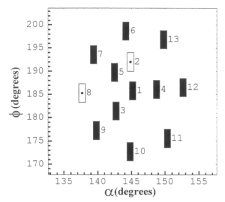 |
Figure 6.69 Collimator pitch and phase scatter plot for the sector pointed out in Figure 6.66 for M1 E3 G2-18:56:31 subenergy 74 keV. The angles are in degrees. The filled in squares represent trajectories that intersected the surface of Ganymede and were absorbed. Open squares are trajectories that missed. |
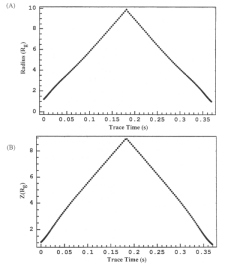 |
Figure 6.70 (A) Length of the radius vector from the center of Ganymede to the particle as a function of trace time in seconds for subenergy 74 keV sublook direction 3 for model M1 channel E3. (B) The Z component of the particle position in GSII coordinates for subenergy 74 keV sublook direction 3 for model M1 channel E3. |
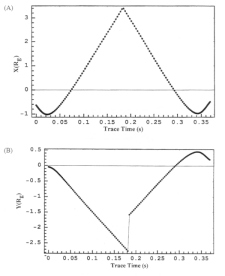 |
Figure 6.71 (A) The X component of the particle position in GSII coordinates for subenergy 74 keV sublook direction 3 for model M1 channel E3. (B) The Z component of the particle position in GSII coordinates for subenergy 74 keV sublook direction 3 for model M1 channel E3. |
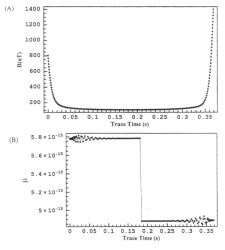 |
Figure 6.72 (A) Magnetic field at the location of the particle as a function of trace time for subenergy 74 keV sublook direction 3 for model M1 channel E3. (B) Magnetic moment at the location of the particle as a function of trace time for subenergy 74 keV sublook direction 3 for model M1 channel E3. |
 |
Figure 6.73 (A) Velocity of the particle as a function of trace time for subenergy 74 keV sublook direction 3 for model M1 channel E3. (B) Pitch angle of the particle as a function of trace time for subenergy 74 keV sublook direction 3 for model M1 channel E3. |
 |
Figure 6.74 ZX projection of the trajectory for subenergy 74 keV sublook direction 3 for model M1 channel E3. |
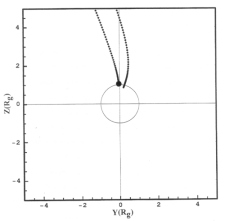 |
Figure 6.75 ZY projection of the trajectory for subenergy 74 keV sublook direction 3 for model M1 channel E3. |
Table 6.8 Summary of the time-reversed particle trace presented in Figures 6.70 through 6.75 for subenergy 74 keV sublook direction 3 for model M1 channel E3.
| Figure | Information | Observation |
| 6.70 | (A) Radius of particle from Ganymede. (B) Z component of particle trajectory. | It is easy to see that the electron makes a complete bounce to interact with Ganymede a second time. |
| 6.71 | (A) X component of particle trajectory. (B) Z component of particle trajectory. | It is easy to see that the electron makes a complete bounce to interact with Ganymede a second time. The Y component graph shows the advancement in the anti-corotation direction. |
| 6.72 | (A) Magnetic field sampled by the particle. (B) Magnetic moment sampled by the particle. | The magnetic field shows a smooth transition between bounces. The magnetic moment is conserved throughout the trajectory. |
| 6.73 | (A) Speed of the particle as it moves through its trajectory. (B) Pitch angle of the particle. | The speed of the electron remains constant throughout the trajectory. The pitch angle decreases to 2.9 radians on the way out and returns at a pitch of .2 radians on the return. |
| 6.74 | ZX projection of the trajectory of the particle. | The electron is shown following the magnetic field line very closely. The return trajectory is difficult to make out. |
| 6.75 | ZY projection of the trajectory of the particle. | The electron follows the magnetic field geometry and cn be seen to return to interact with Ganymede. The geometry of the magnetic field bends back to the -y direction. |
Return to dissertation table of contents page.
Return to main
Galileo Table of Contents Page.
Return to Fundamental
Technologies Home Page.
Updated 8/23/19, Cameron Crane
QUICK FACTS
Mission Duration: Galileo was planned to have a mission duration of around 8 years, but was kept in operation for 13 years, 11 months, and 3 days, until it was destroyed in a controlled impact with Jupiter on September 21, 2003.
Destination: Galileo's destination was Jupiter and its moons, which it orbitted for 7 years, 9 months, and 13 days.



